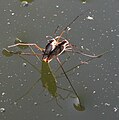
Hemiptera is an order of insects, commonly called true bugs, comprising over 80,000 species within groups such as the cicadas, aphids, planthoppers, leafhoppers, assassin bugs, bed bugs, and shield bugs. They range in size from 1 mm (0.04 in) to around 15 cm (6 in), and share a common arrangement of piercing-sucking mouthparts. The name "true bugs" is often limited to the suborder Heteroptera.
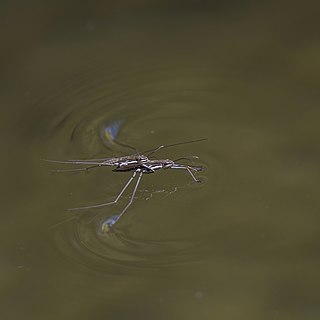
The Gerridae are a family of insects in the order Hemiptera, commonly known as water striders, water skeeters, water scooters, water bugs, pond skaters, water skippers, water gliders, water skimmers or puddle flies. Consistent with the classification of the Gerridae as true bugs, gerrids have mouthparts evolved for piercing and sucking, and distinguish themselves by having the unusual ability to walk on water, making them pleuston (surface-living) animals. They are anatomically built to transfer their weight to be able to run on top of the water's surface. As a result, one could likely find water striders present in any pond, river, or lake. Over 1,700 species of gerrids have been described, 10% of them being marine.
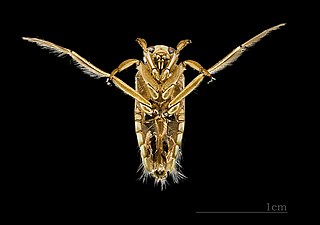
Notonectidae is a cosmopolitan family of aquatic insects in the order Hemiptera, commonly called backswimmers because they swim "upside down" (inverted). They are all predators and typically range from 0.5 to 1.5 cm (0.2–0.6 in) in length. They are similar in appearance to Corixidae, but can be separated by differences in their dorsal-ventral coloration, front legs, and predatory behavior. Their dorsum is convex, lightly colored without cross striations. Their front tarsi are not scoop-shaped and their hind legs are fringed for swimming. There are about 350 species in two subfamilies: Notonectinae with seven genera, and Anisopinae with four genera. Members in the former subfamily are often larger than those in the latter.

Belostomatidae is a family of freshwater hemipteran insects known as giant water bugs or colloquially as toe-biters, Indian toe-biters, electric-light bugs, alligator ticks, or alligator fleas. They are the largest insects in the order Hemiptera. There are about 170 species found in freshwater habitats worldwide, with more than 110 in the Neotropics, more than 20 in Africa, almost as many in the Nearctic, and far fewer elsewhere. These predators are typically encountered in freshwater ponds, marshes and slow-flowing streams. Most species are at least 2 cm (0.8 in) long, although smaller species, down to 0.9 cm (0.35 in), also exist. The largest are members of the genus Lethocerus, which can exceed 12 cm (4.5 in) and nearly reach the length of some of the largest beetles in the world. Giant water bugs are a popular food in parts of Asia.

Velvet water bugs are members of the family Hebridae. They are semiaquatic insects that live among moss or ponds with an abundance of vegetation, in which they prey on small arthropods. Velvet water bugs are the smallest of the Gerromorpha, and have an appearance of tiny veliids. Hebrids sometimes move across water surfaces, but walk or run rather than skate or scull on the surface.

Velia caprai, known as the water cricket, is a species of aquatic bug found in Europe. It grows to a length of 8.5 mm (0.33 in) and is stouter than pond skaters of the family Gerridae. It is distasteful to predatory fish, engages in kleptoparasitism, and can travel at twice its normal speed by spitting on the water surface.

Aquarius remigis, known as the common water strider, is a species of aquatic bug. It was formerly known as Gerris remigis, but the subgenus Aquarius was elevated to generic rank in 1990 on the basis of phylogenetic analysis. Aquarius remigis is found throughout North America, but is most prevalent in the mid-west of the United States.
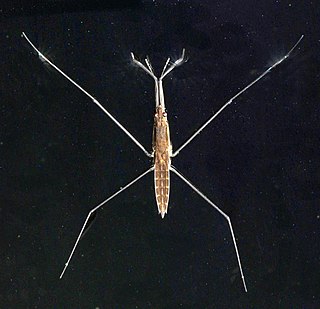
Aquarius najas, also known as the river skater, is a European species of water strider. It was formerly known as Gerris najas, but the subgenus Aquarius was elevated to generic rank in 1990 on the basis of phylogenetic analysis.

Smith Lake is a lake in Fairbanks, Alaska on the property of the University of Alaska Fairbanks. It is triangular in shape, roughly 980 ft × 980 ft × 1,250 ft.
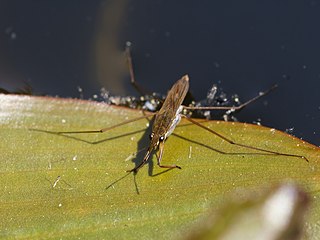
Gerrinae is a subfamily of water strider. This subfamily includes the largest and most best-known group of Gerridae. They are also a phylogenetic subfamily made up of two tribes, and ~14 genera.
Tachygerrini is a tribe of water striders containing 21 species in 2 genera. In addition to the two extant genera, Eurygerris and Tachygerris, Andersen included the extinct genus Eurygerris within the Tachygerrini.

Gerrini is a tribe of water striders containing over 160 species in 12 genera.

Gerris is a bug genus in the family Gerridae.

Aquarius is a genus of water striders found predominantly in the northern hemisphere. Formerly a subgenus, Aquarius was elevated to generic rank in 1990 on the basis of phylogenetic analysis. These are among the world's largest water striders, with females averaging 12–17 mm (0.47–0.67 in) long and males roughly 10–30% smaller, depending on the exact species. An outlier is A. elongatus where both sexes typically are about 24 mm (0.94 in), roughly the same as certain Cylindrostethus, and second only to Gigantometra gigas.
Gerris incognitus is a species of water strider in the family Gerridae. It is found in North America.
Gerris buenoi is a species of water strider that belongs to the family Gerridae. It was first identified in 1911 and is native to continental USA and Canada. Individuals of this species are small in size and have modified appendages, allowing them to float and "skate" along the surface of the water. G. buenoi can be found near the shoreline of freshwater ponds and small lakes, where they hunt for terrestrial insects that have fallen into the water.

